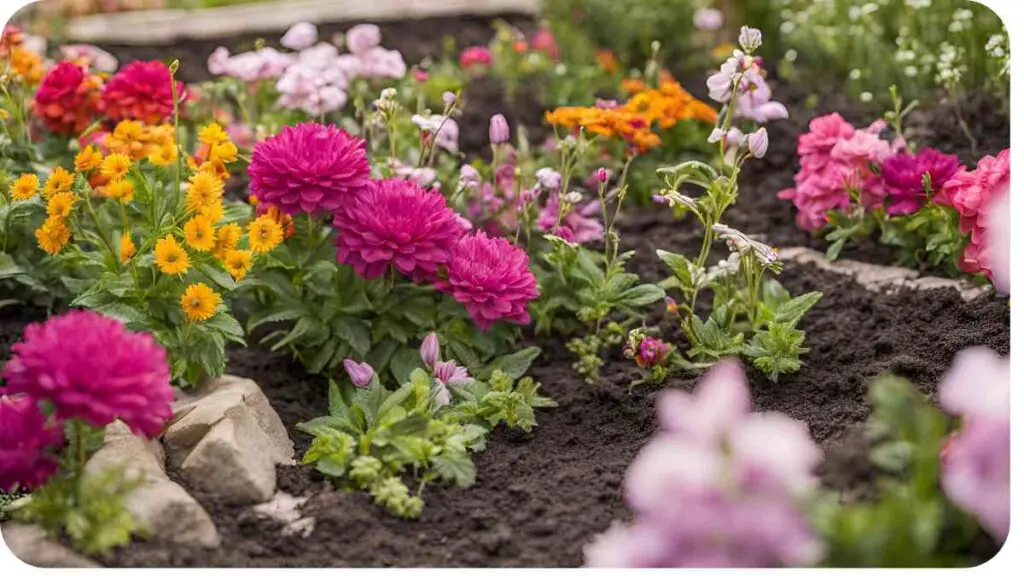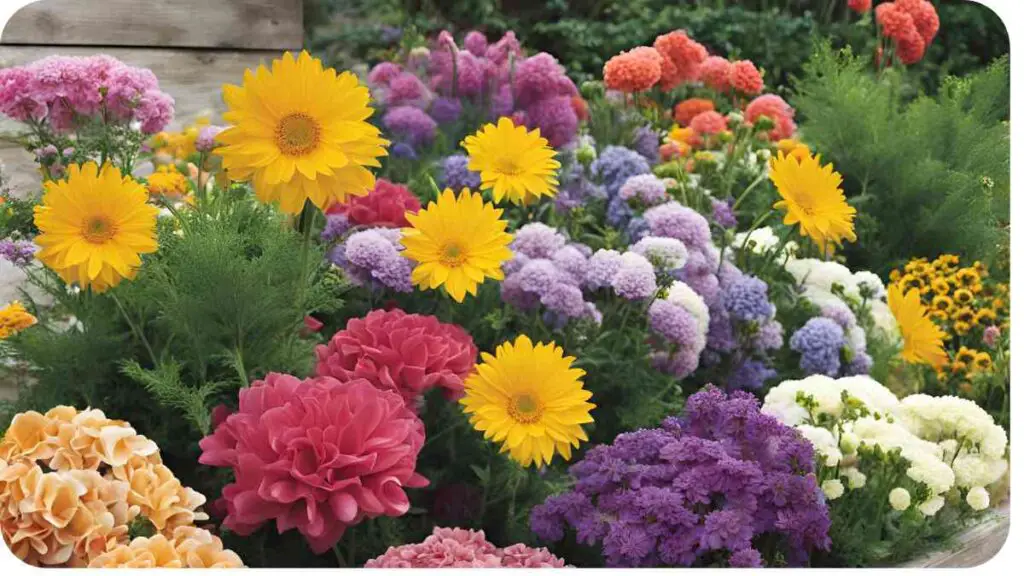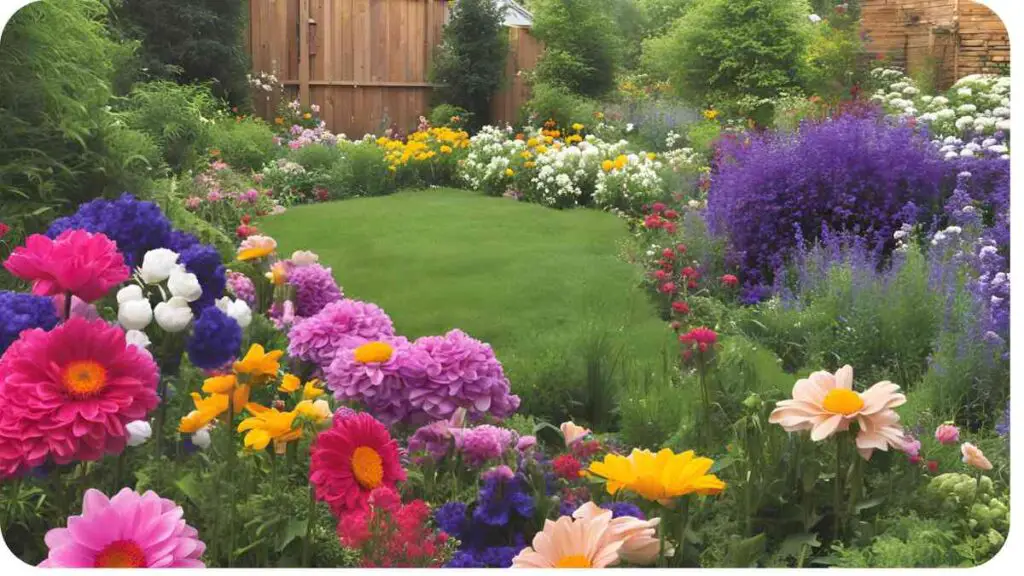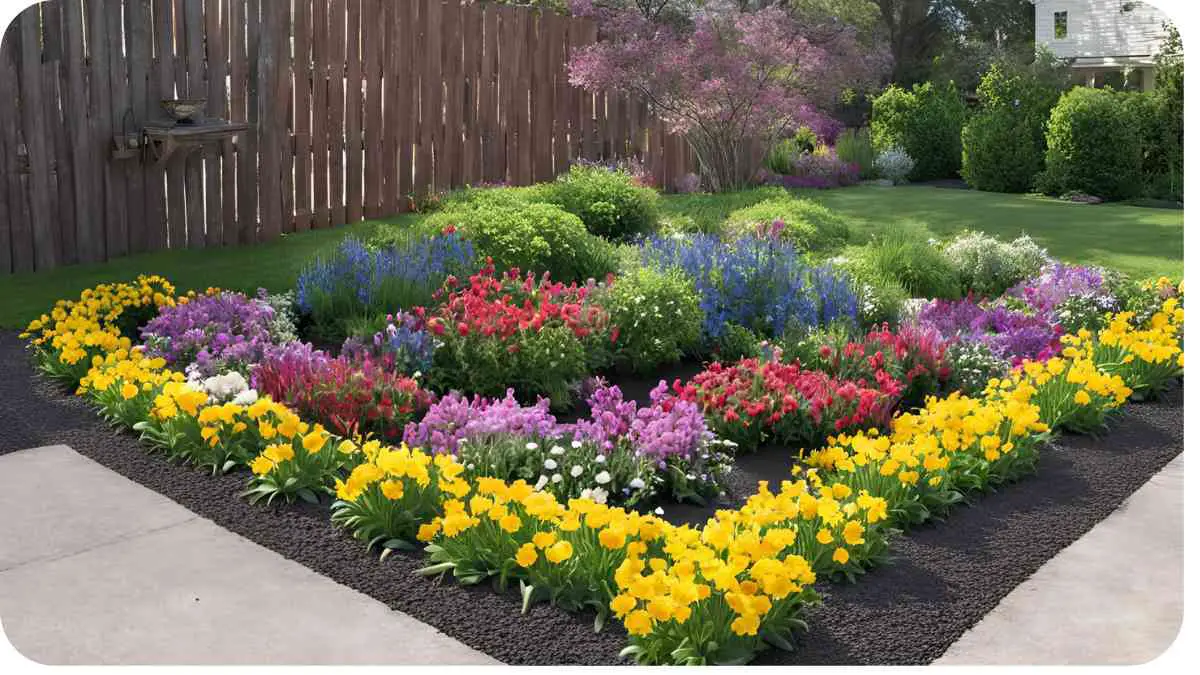Spring is a time of renewal, and for gardeners, it’s the perfect opportunity to breathe life back into their flower beds. After a long winter’s nap, your flower beds might need some TLC to flourish again. In this guide, we’ll explore the essential steps to rejuvenating your flower beds in spring, ensuring a vibrant and colorful garden all season long.
| Takeaways |
|---|
| 1. Assess the current state of your flower beds before beginning spring gardening tasks. |
| 2. Clean out debris, weeds, and dead plants to promote a healthy garden environment. |
| 3. Test and amend your soil as needed to provide essential nutrients for plant growth. |
| 4. Choose a variety of flowers with staggered bloom times to ensure continuous color throughout the season. |
| 5. Apply mulch to conserve moisture, regulate soil temperature, and suppress weed growth. |
| 6. Monitor your flower beds regularly for signs of pests, diseases, or nutrient deficiencies. |
| 7. Implement sustainable gardening practices to create a more eco-friendly garden environment. |
| 8. Incorporate expert tips and tricks from seasoned gardeners to optimize your gardening efforts. |
2. Assessing Your Flower Beds

Before diving into spring gardening tasks, take some time to assess the current state of your flower beds. Look for signs of damage, such as broken branches, compacted soil, or pest infestations. Make note of any areas that may need special attention or repair.
To deter feline intruders from your garden sanctuary, consider planting deterrent plants or installing barriers such as fences or motion-activated sprinklers to keep your flower beds pristine.
| Aspect | Assessment |
|---|---|
| Soil Quality | Check for compacted soil, drainage issues, and nutrient deficiencies. |
| Plant Health | Inspect plants for signs of disease, damage, or overwintering survival. |
| Sunlight Exposure | Note changes in sunlight patterns and adjust planting accordingly. |
| Pest Presence | Look for signs of pest activity and plan pest management strategies. |
3. Cleaning and Preparing
Once you’ve assessed your flower beds, it’s time to roll up your sleeves and get cleaning. Remove any debris, such as fallen leaves, dead plants, or weeds, that may have accumulated over the winter. This not only improves the appearance of your garden but also reduces the risk of disease and pest infestations.
| Task | Description |
|---|---|
| Remove Debris | Clear out fallen leaves, dead plants, and any other debris from the beds. |
| Weed Control | Pull out any weeds that have sprouted and prevent them from taking over. |
| Prune Dead Growth | Trim back dead or damaged branches to encourage new growth. |
| Edge Flower Beds | Define the borders of your flower beds for a neat and tidy appearance. |
As you clean, take the opportunity to assess the overall layout and design of your flower beds. Consider making any adjustments to improve aesthetics or functionality.
4. Soil Amendment
Healthy soil is the foundation of a thriving garden, so it’s essential to amend your soil as needed in the spring. Test your soil to determine its pH level and nutrient content, then make adjustments accordingly.
As the snow melts away, it’s time to revitalize your flower beds by clearing debris, pruning, and adding fresh mulch to encourage healthy growth. Check out this comprehensive guide on how to clean flower beds after winter for a blooming garden this spring.
| Task | Description |
|---|---|
| Soil Testing | Use a soil test kit to assess pH levels and nutrient deficiencies. |
| pH Adjustment | Add lime to raise pH or sulfur to lower pH, if necessary. |
| Organic Matter | Incorporate compost or organic matter to improve soil structure. |
| Fertilization | Apply a balanced fertilizer to provide essential nutrients for plants. |
5. Choosing and Planting Flowers

Now comes the fun part – selecting and planting your spring flowers! Consider factors such as color, size, and bloom time when choosing which flowers to include in your garden. Aim for a mix of annuals and perennials to provide continuous color throughout the season.
| Aspect | Consideration |
|---|---|
| Bloom Time | Select flowers with staggered bloom times for continuous color. |
| Color Palette | Choose a color scheme that complements your existing landscape. |
| Planting Depth | Follow planting guidelines for each flower species to ensure proper depth. |
| Spacing | Allow adequate space between plants to accommodate growth. |
When planting, be sure to loosen the soil and water your flowers thoroughly to help them establish roots. Consider using mulch to conserve moisture and suppress weeds.
6. Mulching
Mulching is a crucial step in maintaining healthy flower beds throughout the growing season. Apply a layer of mulch around your plants to help retain moisture, regulate soil temperature, and suppress weed growth.
| Material | Benefits |
|---|---|
| Organic Mulch | Decomposes over time, enriching the soil with organic matter. |
| Inorganic Mulch | Long-lasting and helps conserve moisture in the soil. |
| Mulch Depth | Aim for a 2-3 inch layer of mulch to provide adequate coverage. |
| Mulching Techniques | Apply mulch in a donut shape around plants, keeping it away from stems. |
7. Watering and Maintenance
Proper watering and maintenance are essential for keeping your flower beds healthy and vibrant. Pay attention to your plants’ water needs and adjust your watering schedule accordingly, especially during hot and dry periods.
Don’t let weeds overrun your flower beds! Discover effective strategies and tools to reclaim your garden oasis with this comprehensive guide on how to get rid of flower beds in full weeds. Take back control and restore beauty to your outdoor space.
| Task | Description |
|---|---|
| Watering Schedule | Develop a watering schedule based on plant needs and weather conditions. |
| Watering Techniques | Water at the base of plants to minimize evaporation and fungal growth. |
| Drip Irrigation | Consider installing drip irrigation systems for efficient watering. |
| Rainwater Harvesting | Utilize rain barrels to collect and store rainwater for watering plants. |
In addition to watering, regular maintenance tasks such as deadheading spent blooms, pruning, and fertilizing can help promote healthy growth and prolong flowering.
8. Dealing with Pests and Weeds
Pests and weeds can wreak havoc on your flower beds if left unchecked. Implementing integrated pest management strategies can help keep pests at bay while minimizing the use of harmful chemicals.
| Pest Control | Strategy |
|---|---|
| Natural Predators | Encourage beneficial insects and birds that feed on garden pests. |
| Companion Planting | Plant pest-repellent flowers and herbs alongside your main crops. |
| Organic Pest Control | Use organic insecticidal soaps or neem oil to control pests naturally. |
| Weed Management | Mulch regularly and hand-pull weeds as soon as they appear. |
By staying vigilant and addressing pest and weed issues promptly, you can maintain a healthy and pest-free garden without resorting to harsh chemicals.
9. Reviving Overwintered Plants
If you have perennial plants that have overwintered in your flower beds, they may need some extra care to revive them for the new growing season. Assess the condition of your overwintered plants and take steps to encourage new growth.
| Plant | Revival Techniques |
|---|---|
| Perennial Flowers | Trim back dead foliage and provide supplemental water and nutrients. |
| Shrubs | Prune dead or damaged branches and fertilize to promote new growth. |
| Bulbs | Remove any dead foliage and topdress with compost or fertilizer. |
| Groundcovers | Trim back overgrown areas and divide clumps to rejuvenate growth. |
With proper care and attention, overwintered plants can bounce back and thrive in the spring garden.
10. Monitoring and Adjusting

Gardening is a dynamic process, and it’s essential to monitor your flower beds regularly and make adjustments as needed. Keep an eye out for signs of stress or nutrient deficiencies in your plants, and be prepared to take corrective action.
Unwanted rodent visitors can wreak havoc on your flower beds. Learn practical and humane methods for keeping rats at bay to protect your plants and maintain a pest-free garden environment throughout the seasons.
| Aspect | Monitoring and Adjustment |
|---|---|
| Plant Health | Check for signs of disease, pest infestation, or nutrient deficiency. |
| Soil Moisture | Monitor soil moisture levels and adjust watering as necessary. |
| Weather Conditions | Be mindful of changing weather patterns and their impact on plants. |
| Growth Patterns | Observe how plants are responding to their environment and make adjustments. |
By staying proactive and responsive to changes in your garden, you can ensure optimal growing conditions for your plants.
11. Tools and Equipment
Having the right tools and equipment can make gardening tasks much more manageable and efficient. Invest in high-quality tools that are suitable for the tasks you’ll be performing in your flower beds.
| Tool | Description |
|---|---|
| Hand Trowel | Ideal for planting small flowers or digging up weeds. |
| Pruning Shears | Essential for trimming back dead or overgrown branches. |
| Garden Fork | Useful for loosening compacted soil and incorporating amendments. |
| Watering Can | Provides a gentle and controlled way to water plants. |
Consider also investing in ergonomic tools to reduce strain and fatigue during long gardening sessions.
12. Sustainable Practices
Incorporating sustainable gardening practices not only benefits the environment but also helps maintain a healthy and thriving garden for years to come. Consider implementing the following sustainable practices in your flower beds:
| Practice | Description |
|---|---|
| Composting | Recycle organic waste into nutrient-rich compost for your garden. |
| Rainwater Harvesting | Collect and store rainwater to reduce reliance on municipal water sources. |
| Native Planting | Choose native plants that are adapted to your region’s climate and soil. |
| Chemical-Free Pest Control | Use natural predators, traps, and organic methods to control pests. |
By adopting sustainable gardening practices, you can create a more resilient and eco-friendly garden that thrives for generations.
13. Expert Tips and Tricks
To take your spring flower bed care to the next level, consider incorporating these expert tips and tricks into your gardening routine. These insights from seasoned gardeners can help you achieve outstanding results in your flower beds.
Combatting weeds in flower beds requires the right weed killer. Explore different types and their effectiveness in this guide on what kind of weed killer can you use in flower beds. Keep your garden flourishing and free from unwanted invaders with the right solutions.
| Expert | Tip |
|---|---|
| Emily Green | “Start with a clean slate by removing all weeds and dead plant material.” |
| John Gardener | “Mulch not only conserves moisture but also adds organic matter to the soil.” |
| Lily Bloom | “Plant taller flowers towards the back of the bed to create depth and visual interest.” |
| Sam Soilman | “Regular soil testing is key to understanding your garden’s nutrient needs.” |
By incorporating these expert tips into your gardening routine, you can achieve stunning results in your flower beds this spring.
14. Conclusion
Spring is a time of rejuvenation and renewal, and there’s no better way to celebrate than by tending to your flower beds. By following the steps outlined in this guide, you can ensure that your flower beds are ready to burst into bloom with vibrant colors and lush foliage.
From assessing and preparing your flower beds to choosing the perfect flowers and maintaining them throughout the season, each step plays a crucial role in the success of your garden. By incorporating sustainable practices and expert tips into your gardening routine, you can create a beautiful and thriving garden that brings joy and beauty to your outdoor space.
Further Reading
- A Simple Checklist to Get Your Flower Beds Ready for Spring: This article provides a straightforward checklist to prepare your flower beds for spring, ensuring a successful gardening season ahead.
- How to Prepare Flower Beds for Spring Planting: Discover expert tips and techniques for preparing your flower beds for spring planting, ensuring healthy and thriving plants.
- 8 Rules for Planting the Perfect Spring Garden: Learn the essential rules for planting a perfect spring garden, from selecting the right plants to proper planting techniques and maintenance tips.
FAQs
What are some essential tasks for preparing flower beds in spring?
Spring is the perfect time to rejuvenate your flower beds. Essential tasks include cleaning out debris, weeding, amending the soil, and planting new flowers.
How do I choose the right flowers for my spring garden?
When selecting flowers for your spring garden, consider factors such as bloom time, color palette, and sun exposure. Choose a mix of annuals and perennials for continuous color throughout the season.
What is the importance of mulching in spring gardening?
Mulching helps retain moisture, regulate soil temperature, and suppress weed growth in flower beds. It also adds organic matter to the soil as it breaks down, improving overall soil health.
How can I prevent pests and weeds in my flower beds?
Implementing integrated pest management strategies and practicing regular weed control can help prevent pests and weeds in your flower beds. Consider using natural predators, companion planting, and organic pest control methods.
What should I do with overwintered plants in spring?
Overwintered plants may need some extra care to revive them for the new growing season. Trim back dead foliage, provide supplemental water and nutrients, and monitor their growth for signs of recovery.

For 15 years, Hellen James has worked in the gardening industry as an expert and landscape designer. During her career, she has worked for a variety of businesses that specialize in landscaping and gardening from small firms to large corporations.

